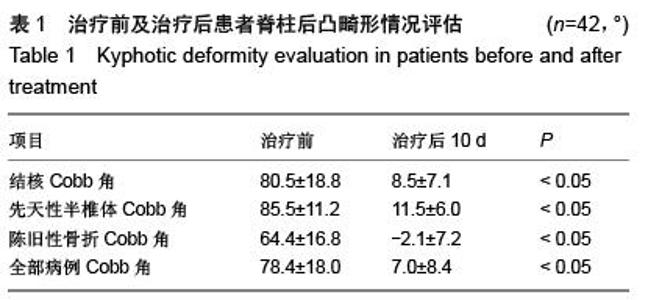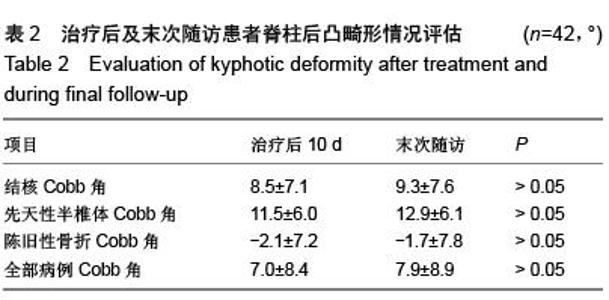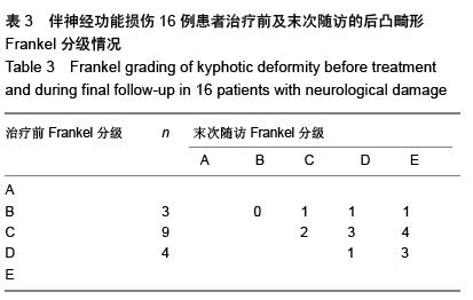| [1] 李危石,陈仲强,郭昭庆,等.前后路联合手术治疗胸腰段僵硬性角状后凸畸形[J].中国脊柱脊髓杂志,2004,14(11)845-847.
[2] 丘勇.提高对脊柱矫形手术神经并发症的防范[J].中国脊柱脊髓杂志,2008,18(3):165-166.
[3] McMaster MJ,Ohtsuka K.The natural history of congenital scoliosis.A study of two hundred and fifty-one patients.J Bone Joint Surg (Am). 1982;64(8):1128-1147.
[4] Bradford DS,Boachie-Adjei O.One-stage anterior and posterior hemivertebral resection and arthrodesis for congenital scoliosis. J Bone Joint Surg(Am). 1990;72(4):536-540.
[5] King JD,Lowery GL.Results of lumbar hemivertebral excision for congenital scoliosis. Spine. 1991;16(7):778-782.
[6] Holte DC,Winter RB,Lonstein JE,et al.Excision of hemivertebrae and wedge resection in the treatment of congenital scoliosis.J Bone Joint Surg(Am). 1995;77(2):159-171.
[7] Lazar RD,Hall JE.Simultaneous anterior and posterior hemivertebra excision.Clin Orthop Relat Res. 1999;364:76-84.[8] Klemme WR,Polly DW,Orchoeski JR.Hemivertebral excision for congenital scoliosis in very young children.J Pediatr Orthop. 2001;21(6):761-764.
[9] 仉建国,邱贵兴,刘勇,等. 前后路一期半椎体切除术矫治脊柱侧后凸[J]. 中华骨科杂志,2004,24(5):257-261.
[10] ZidornT,Krauspe R,Eulert J.Dorsal hemivertebrae in children’s lumbar spines. Spine. 1994;19(21):2456-2460.
[11] Shono Y,Abumi K,Kaneda K.One-stage posterior hemivertebra resection and correction using segmental posterior instrumentation. Spine. 2001;26(7):752-757.
[12] Nakamura H,Matsuda H,Konishi S,et al.Single-stage excision of hemivertebrae via the posterior approach alone for congenital spine deformity: follow-up period longer than ten years.Spine. 2002;27(1):110-115.
[13] Ruf M,Harma J.Hemivertebra resection by a posterior approach;Innovative operative technique and first results. Spine. 2002;27(10):1116-1123.
[14] Ruf M,Harms J.Posterion hemivertebra resection with transpedicular instrumentation:early correction in children aged 1 to 6 years.Spine. 2003;28(18):2132-2138
[15] 霍洪军,邢文华,杨学军,等.脊柱结核手术治疗方式的选择[J].中国脊柱脊髓杂志,2011, 21(10):819-824.
[16] Jin DD,Qu DB,Chen JT,et al.One-stage anterior underbody auto grafting and instrumentation in primary surgical management of thoracolumbar spinal tuberculosis. Eur Spine J. 2004;13(2):114-121.
[17] 杨克勤,主编.脊柱疾患的临床与研究[M]. 北京:北京出版社, 1993: 228.
[18] 胥少汀,郭世绂. 脊髓损伤基础与临床[M]. 北京:人民出卫生版社,1993: 41.
[19] 陈仲强,党耕町,郭昭庆,等.胸腰段僵硬性角状后凸畸形对下腰椎的影响及外科治疗[J].中华外科杂志,2000,38(11)824-826.
[20] Shimode M, Kojima T,Sowa K.Sponal wedge osteotomy by a single posterior approach for correction of serere and rigid kyphosis or kyphoscoliosis.Spine. 2002;27(20): 2260-2267.
[21] Kawahara N,Tomita K,Baba H,et al.Closing-opning wedge osteotomy to correct angular kyphotic deformity by a single posterior approach. Spine. 2001;26(4):391-402.
[22] Suk SI,Kim JH,Kim WJ,et al.Posterior vertebral column resection for severe spinal deforitis.Spine. 2002;27(21): 2374-2382.
[23] Domanic U,Tomita Dikici F,et al. Surgicai correction lf kyphosis posterior total wedge resection osteotomy in 32 patients. Acta Orthop Scand. 2004;75(4):449-455.
[24] Lehmer SM,Keppler L,Biscup RS,et al. Posterior transvertebral osteotomy for adult thoracolumbar kyphosis. Spine. 1994;19(18):2060-2067.
[25] Murrey DB,Brigham CD,Kiebzak G,et al.Transpedicular decom_ pression and pedicle subtraction osteotomy(eggshell procedure):a retrospective review of 59 patients. Spine. 2002; 27 (21): 2338-2345.
[26] 史亚民,候树勋,王东华,等.后路椎体截骨矫正僵硬性脊柱侧后凸畸形[J].中华骨科杂志,2004,24(5):321-324.
[27] Thomasen E.Vertebral osteotomy for correction of kyphosis in ankylosing spondylitis.Clin Orthop. 1985;194(2):142-152.
[28] Willens KF,Slot GH,Anderson PG,et al.Spinal osteotomy in patients with ankylosing spondylitis:complications during first postope-rative year. Spine. 2005;30(1):101-107. |





